
The Palais Bourbon is the meeting place of the National Assembly, the lower legislative chamber of the French Parliament. It is located in the 7th arrondissement of Paris, on the Rive Gauche of the Seine, across from the Place de la Concorde.

The Parliament of Wallonia is the legislative body of Wallonia, one of the three self-governing regions of Belgium. The parliament building, the former Hospice Saint-Gilles, is situated in Namur, the capital of Wallonia, at the symbolic confluence of the Meuse and the Sambre, the two main rivers of the most inhabited parts of Wallonia, the Sillon industriel. On the other side of the Meuse, facing the Parliament, is the Élysette, the seat of the Government of Wallonia.
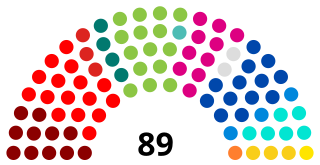
The Parliament of the Brussels-Capital Region, is the governing body of the Brussels-Capital Region, one of the three regions of Belgium. It is also known as the Brussels Regional Parliament.
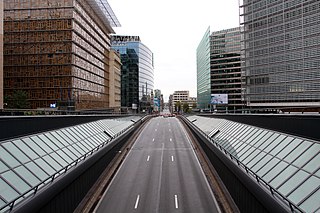
The Rue de la Loi or Wetstraat (Dutch), meaning "Law Street", is a major street running through central and eastern Brussels, Belgium, which is famous due to the presence of several notable Belgian and European Union (EU) governmental buildings. The road runs from the Rue Royale/Koningsstraat, in central Brussels, to the Robert Schuman Roundabout in its European Quarter. It forms the first (westerly) part of the N3 road that runs to Aachen, Germany.

The Egmont Palace, also sometimes known as the Arenberg Palace, is a neoclassical palace in Brussels, Belgium. It was originally built between 1548 and 1560 for Countess Françoise of Luxembourg and Count Lamoral of Egmont, though its appearance was heavily modified in the 18th and 19th centuries. It was partly destroyed by fire in 1892, after which it was once again reconstructed. Nowadays, it is used by the Belgian Ministry of Foreign Affairs for receptions, as a guest house and conference centre.
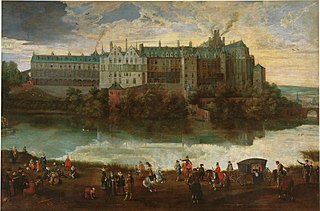
The Palace of Coudenberg was a royal residence situated on the Coudenberg or Koudenberg, a small hill in what is today the Royal Quarter of Brussels, Belgium.

The Royal Palace of Brussels is the official palace of the King and Queen of the Belgians in the centre of the nation's capital, Brussels. However, it is not used as a royal residence, as the king and his family live in the Royal Palace of Laeken in northern Brussels. The website of the Belgian Monarchy describes the function of the Royal Palace as follows:
The Royal Palace is where His Majesty the King exercises his prerogatives as Head of State, grants audiences and deals with affairs of state. Apart from the offices of the King and the Queen, the Royal Palace houses the services of the Grand Marshal of the Court, the King's Head of Cabinet, the Head of the King's Military Household and the Intendant of the King's Civil List. The Royal Palace also includes the State Rooms where large receptions are held, as well as the apartments provided for foreign Heads of State during official visits.
The seven institutions of the European Union (EU) are seated in four different cities, which are Brussels (Belgium), Frankfurt am Main (Germany), Luxembourg (Luxembourg) and Strasbourg (France), rather than being concentrated in a single capital city. All four were chosen, among various reasons, for their location halfway between France and Germany, the countries whose rivalry led to two World Wars and whose reconciliation paved the way for European integration. The EU agencies and other bodies are located all across the union, but usually not fixed in the treaties. The Hague is the only exception, as the fixed seat of the Agency for Law Enforcement Cooperation (Europol). Luxembourg City is the EU capital that can lay claim to having the most of the seven EU institutions based wholly or partly upon its territory, with only the European Council and European Central Bank not having a presence in the city. Over the years, Brussels has become the EU's political hub, with the College of the Commissioners – the European Commission's politically accountable executive – and the European Council both meeting at their Brussels-based headquarters, and the European Parliament and Council of the EU holding the majority of their meetings annually within the city. This has led media to describe it as the de facto "capital of the EU".

The city of Strasbourg in France is the official seat of the European Parliament. The institution is legally bound by the decision of Edinburgh European Council of 11 and 12 December 1992 and Article 341 of the TFEU to meet there twelve times a year for a session, each of which usually takes about four days. The majority of work, however, takes place in Brussels, and some other work is undertaken in Luxembourg City. Also all votes of the European Parliament must take place in Strasbourg. "Additional" sessions and committees take place in Brussels. Although de facto a majority of the Parliament's work is now geared to its Brussels site, it is legally bound to keep Strasbourg as its official home; a situation which garners much criticism from the European Parliament itself, as well as many interest groups, administrative staff, and environmentalist groups amongst others.

Brussels (Belgium) is considered the de facto capital of the European Union, having a long history of hosting a number of principal EU institutions within its European Quarter. The EU has no official capital but Brussels hosts the official seats of the European Commission, Council of the European Union, and European Council, as well as a seat of the European Parliament. In 2013, this presence generated about €250 million and 121,000 jobs. The main rationale for Brussels being chosen as "capital of the European Union" was its halfway location between France, Germany and the United Kingdom, the three countries whose rivalry played a role in starting the two World Wars and whose reconciliation paved the way for European integration.

Alphonse Hubert François Balat was a Belgian architect.

The Palace of the Nation is a neoclassical palace in Brussels, Belgium, housing the Belgian Federal Parliament.

La Cambre Abbey or Ter Kameren Abbey is a former Cistercian abbey in the City of Brussels, Belgium. It is located in the Maelbeek valley between the Bois de la Cambre/Ter Kamerenbos and the Ixelles Ponds. The abbey church is a Catholic parish of the Archdiocese of Mechelen–Brussels and home to a community of Norbertine canons, while other parts of the monastery house the headquarters of the Belgian National Geographic Institute (NGI) and La Cambre, a prestigious visual arts school.

The Espace Léopold or Leopoldruimte is the complex of parliament buildings in Brussels, Belgium, housing the European Parliament, a legislative chamber of the European Union (EU). It consists of a number of buildings, primarily the oldest, the Paul-Henri Spaak building, which houses the debating chamber and the President's offices, and the Altiero Spinelli building, which is the largest. The buildings are located in the European Quarter of Brussels, with construction starting in 1989.

The Esplanade of the European Parliament, or simply the Mall, is a pedestrian mall in Brussels, Belgium, completed in 2002. Its most representative parts are the Solidarność 1980 Esplanade and the Simone Veil Agora.
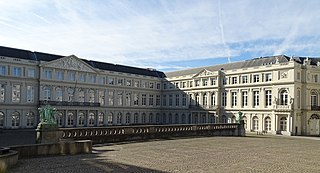
The Palace of Charles of Lorraine is a neoclassical palace in the Royal Quarter of Brussels, Belgium. Its construction started in 1757 to serve as the residence of the Governor of the Habsburg Netherlands, Prince Charles Alexander of Lorraine, replacing the Palace of Orange-Nassau. It currently houses a museum, part of the Royal Library of Belgium (KBR).

The Cinquantenaire Arcade is a memorial arcade in the centre of the Parc du Cinquantenaire/Jubelpark in Brussels, Belgium. The centrepiece is a monumental triple arch known as the Cinquantenaire Arch. It is topped by a bronze quadriga sculptural group with a female charioteer, representing the Province of Brabant personified raising the national flag.
Gustave Hansotte (1827-1886) was a 19th-century Belgian architect, representative of neoclassical architecture and eclectic architecture of Belgium.

The Palace of the Count of Flanders is a neoclassical palace in Brussels, Belgium. It was originally built between 1776 and 1781 for Countess Brigitte of Tirimont-Templeuve, though it was heavily expanded in the 19th century. Nowadays, it houses the Court of Audit of Belgium.
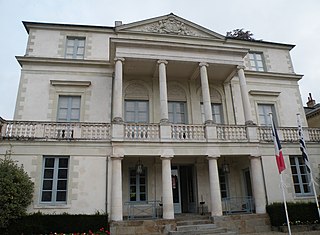
Hôtel de Courcy is a private mansion located in Rennes, 9 rue Martenot, opposite the La Motte square and near Parc du Thabor. Built in around 1830, it was the property of several families of Rennes before being transferred to the State during the 20th century.





















